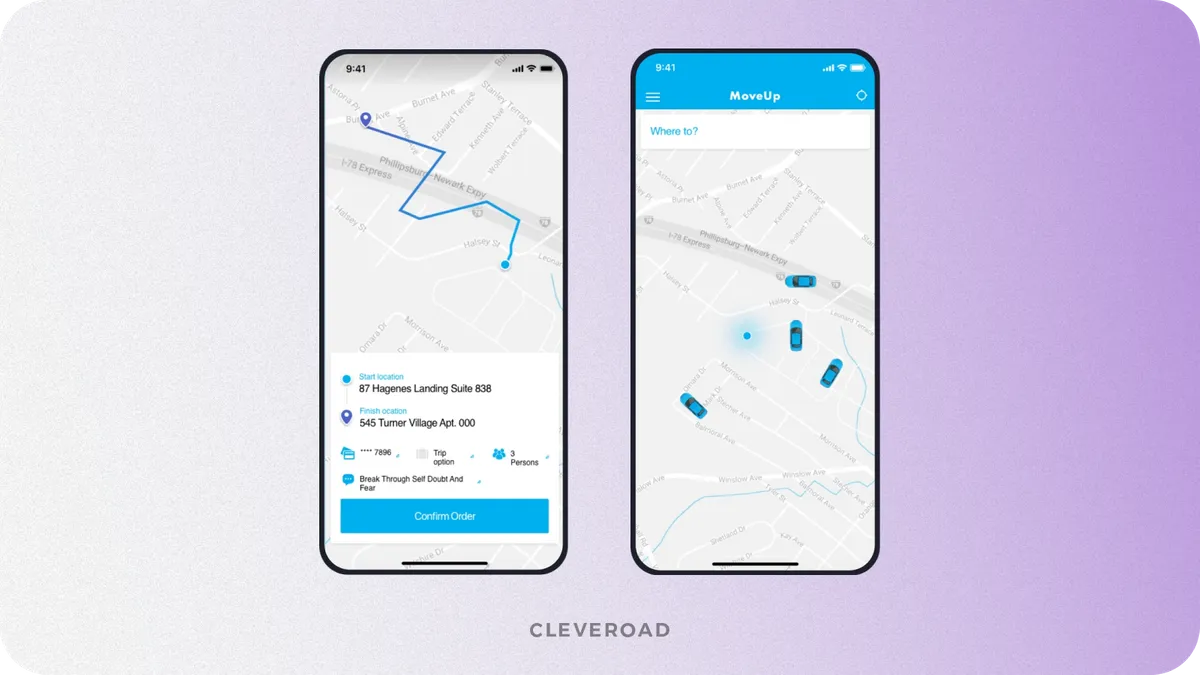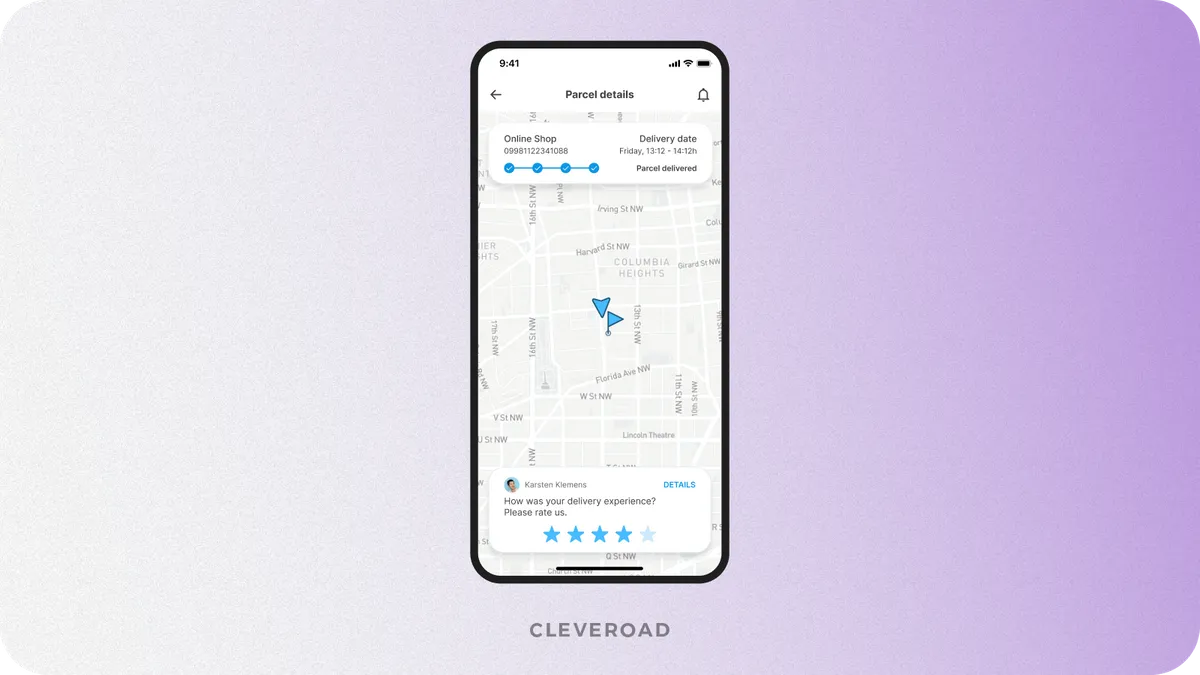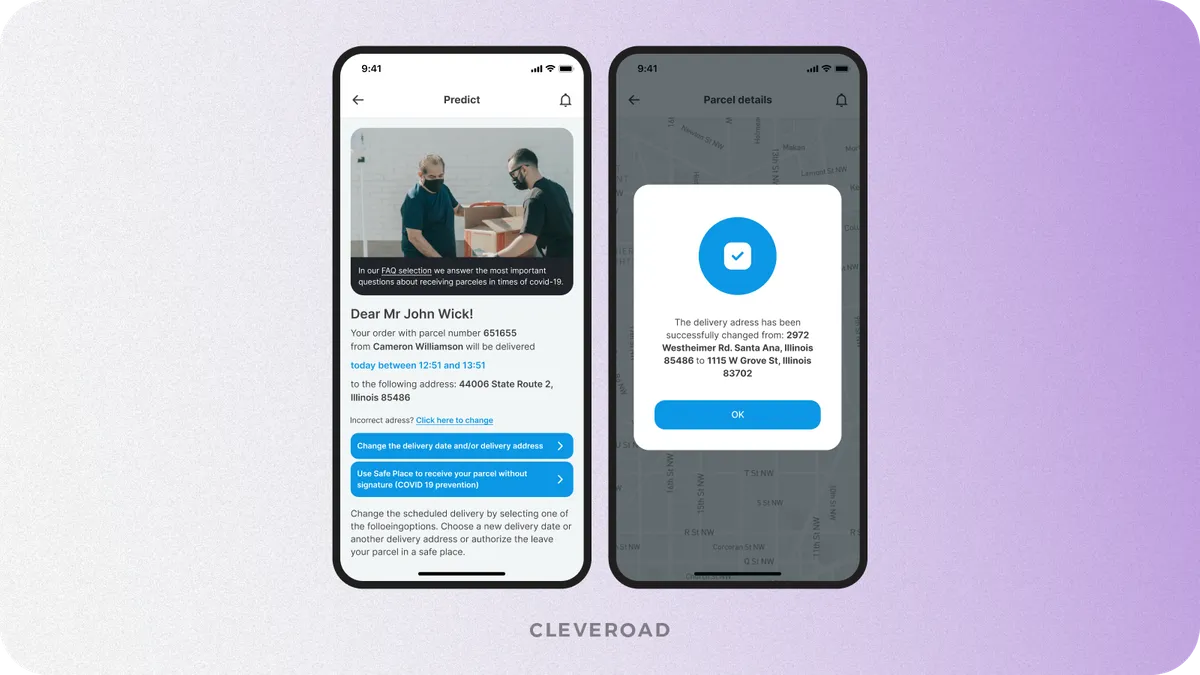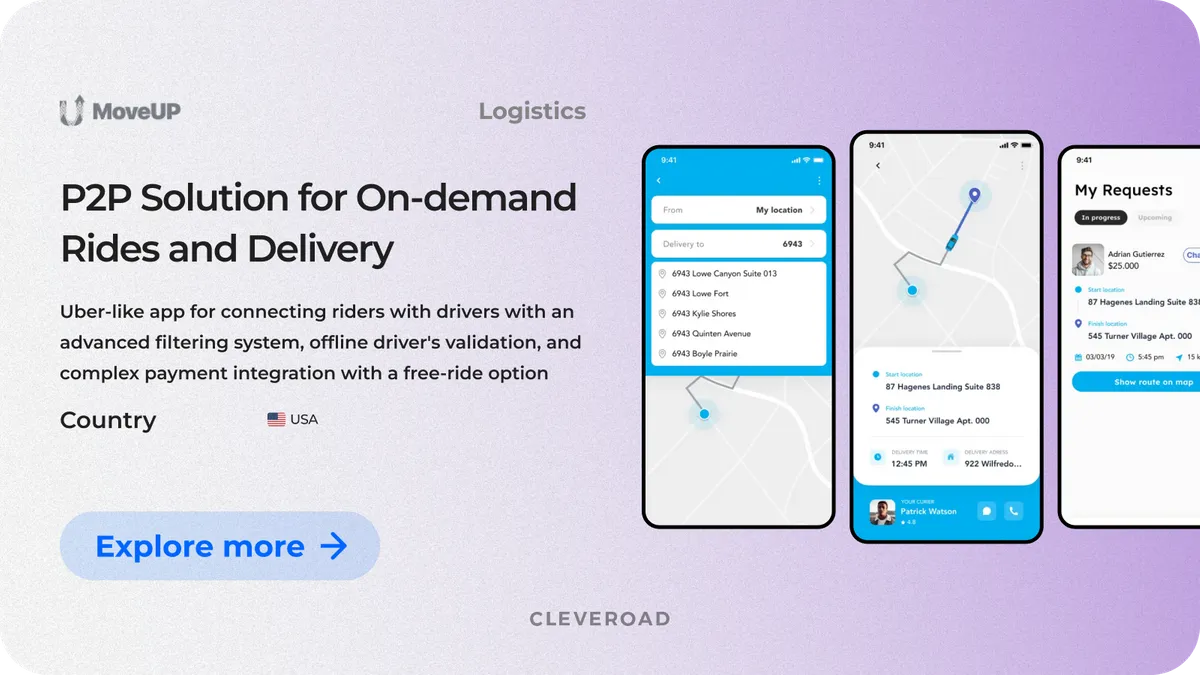How to Create a Rideshare App in 2025: Benefits, Must-Have Features, and Development Guide
Updated 12 Aug 2025
18 Min
32879 Views
Ride sharing app development has become a new trend thanks to platforms like Uber and Lyft that disrupted the transportation market and turned into billion-dollar ventures. But you don’t have to compete head-on with global giants to succeed in this space. Localized or niche-specific ride-sharing apps are in high demand, especially where traditional taxi services fall short or convenience is lacking.
At Cleveroad, we have 13+ years of experience in rideshare app development, building tailored solutions for both startups and established transportation providers. Our team has delivered scalable platforms with real-time GPS tracking, driver-rider matching algorithms, in-app payments, fleet management tools, and more.
Based on our experience, we’ll explain how to create your own rideshare app, what features to include, what people to hire, and how much it will cost you. In case you would like to under how to start a rideshare business and build a solution for this, here's the list below. You will find essential steps to complete ride sharing app development successfully:
- Requirements assembling
- Project planning
- UI/UX designing process
- Software development and functionality implementation
- Quality Assurance testing
- Launching on the market
- Further maintenance and support
We'll also disclose the steps mentioned above later in this article.
Ride Sharing App Development: Notion and Peculiarities
We can describe ridesharing (also called carpooling) as a shared utilization of a private vehicle found via the services to find companions for the trip. Traditionally, the cost of travel is split depending on the required destination. Besides, it's optimal for all the travel fellows as well as the driver (who possesses the car) and is built without substantial deviations from the primary road.
According to the way of scheduling a united road, there are the following types of ridesharing:
- Traditional. Commonly, it implies a three-day (100 km and more) travel, built willfully (taking approximately from a single day to several months).
- Dynamic. This type refers to traveling within the municipal area at small distances (up to 100 km) while having alternatives, such as using the private car, public transport, ordering a taxi, any other types of vehicles, or afoot.
- Regular. Such an option stands for the same and remaining ride participants, the route, and the alignment of the orderly travel.
The main point of ride-sharing app development is essentially to cut down travel expenses. Taking into consideration the number of companions as well as the route distance, there is an opportunity to save up to 70% of the cost of using public vehicles.
An excellent opportunity for drivers is to get payment from each travel fellow. Apart from this, the expenses cover not only fuel but also include parking, toll roads, and other aspects of the trip that require considerable expenses.
To perform longer routes, a great benefit for the car owner is to share the steering wheel with the passengers so that each one can drive alternately. Some drivers are also willing to find a company for the trip to make it more engaging. Friendly conversations, music, and new acquaintances are also appreciated by many users.
How ridesharing applications work
You can call your trip a rideshare only if it meets the following criteria:
- The car owner doesn't provide taxi services, they start the trip whether they have companions or not
- Car owner saves on fuel costs, but they don't make money on the trip
- All passengers share a total ride cost
Sometimes drivers look for companions not to share costs but to have a rest during long trips. Or just a person to chat with. In the first case, riders should have a driving license and be ready to replace driver.
The main idea of the ride sharing app development is to build an app that organizes a group of people going to the same place. And the most convenient way is to connect drivers and riders via a mobile app like UberPool, Lyft’s Shared Rides, or BlaBlaCar.
Here’s how ridesharing apps work:
- Request. Car owners specify where they’re going, where they'd like to pick up and drop off passengers, and when.
- Booking. Passengers look through the list of trips, cars, and drivers' ratings, and book a ride.
- Payment. Passengers pay in the app or in cash when they get in the car.
- Rating. Riders rate the trip and leave their reviews.
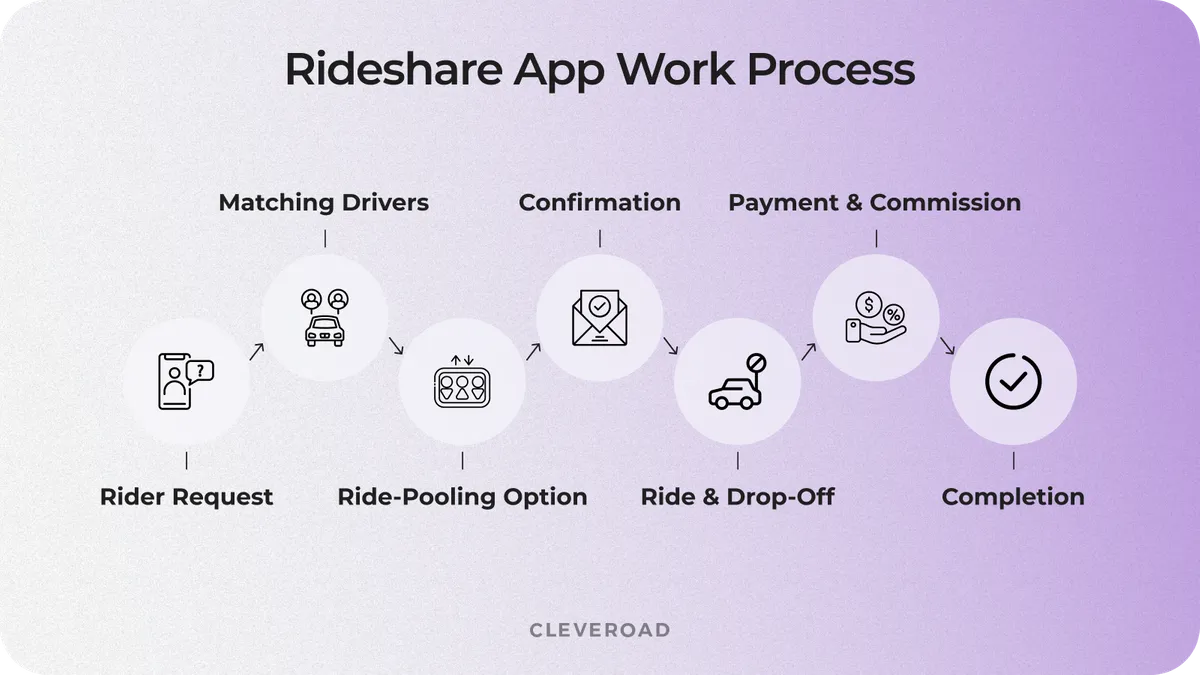
Rideshare app work process
Ride Sharing App Development Value for Business
Launching a ridesharing app opens the door to one of the fastest-growing segments in urban mobility. Unlike traditional taxis, ridesharing service matches passengers who travel in the same direction, optimizing routes and reducing empty seats. This model not only helps riders save money but also gives businesses a powerful way to tap into high demand with lower operational costs.
For your company, a well-built rideshare app can become a steady revenue source through commission fees, subscriptions, or partnerships with corporate clients. Your users will benefit from affordable transportation, faster pick-ups, and a more sustainable way to travel. By offering a convenient digital platform that connects drivers and passengers in real time, you position your brand as both a service provider and an innovator in eco-friendly, cost-efficient transport, meeting the expectations of today’s socially conscious and price-sensitive customers.
Expenses reduction
The primary advantage when you decide to create ride sharing app is cost-efficiency. For drivers, passengers are charged proportionally for fuel, repairs, parking, etc. The higher the number of companions, the lower the cost of the trip, as it is split among them. Studies show that adding just one additional passenger per 100 vehicles could save 0.8 – 0.82 billion gallons of gasoline/year, or 7.2 – 7.74 billion gallons/year if one extra passenger per 10 vehicles (Source: Jacobson & King).
Cut down traffic jams
A great challenge faced in big cities, which interferes with the capability to travel through space fast, is the huge traffic. Opting to create rideshare app allows for simple and rapid planning of routes for several passengers traveling in one vehicle. Thus, it reduces traffic congestion. A simulation of high-capacity ride-sharing (vehicles carrying 2–6 people) shows a 3%–5% reduction in overall traffic congestion, scaling with vehicle occupancy (Source: Cornell).
Alternating driving
Long-distance roads can be fatiguing and stressful for drivers. Ride sharing app development ensures the opportunity for trip participants to drive in turn, which is more convenient and less tiring. A report from Transport Research indicates that alternating drivers on long trips reduces driver fatigue risk by 40%, improving road safety.
Environment care
Thanks to rideshare apps, emissions of harmful gases are not completely eliminated, but are significantly cut down (Source: European Journal of Operational Research). This is due to the fewer vehicles required for trips since travel fellows utilize fewer vehicles. Besides, the significant issue of global warming is also partially overcome.
New acquaintances
United trips provided by rideshare apps are great for finding new friends and acquaintances. In today's individualistic and independence-oriented society, such an opportunity can be very valuable. According to a Springer study, 72% of carpoolers reported increased social interaction, with 46% forming new friendships or professional networks.
Trip convenience
A ride-sharing app similar to Uber makes travel smoother by letting passengers book a ride in seconds, see exact pick-up times, and track drivers in real time, while the system automatically selects the fastest route based on traffic. This reduces waiting, avoids detours, and delivers predictable arrival times, creating a stress-free, door-to-door experience.
Opt for our last mile delivery software development services to improve your transportation business efficiency and stay ahead of competitors
Must-Have Features for Ride Sharing App Development
We’re taking the BlaBlaCar app as an example of a ridesharing app and reviewing its essential features. Unlike Uber, BlaBlaCar doesn’t have an app for riders and another one for drivers. Everything is done via the same platform by switching between rider and driver modes.
Registration & profile
Most apps ask users to enter their email, phone number, and generate a password. And it’s a good idea to offer sign-ups or ins via Facebook, Twitter, or Google as it saves your users’ time.
As for the profiles, you don’t need to include tons of features. Especially if you're creating an MVP, let users upload a photo, enter their name, phone, and car license numbers, add a payment method, and check their payment history.
Or you may opt for more complex functionality. BlaBlaCar lets users set preferences in their profiles (chattiness, smoking, music), and add car details—number plate, car make, model, type, color, and the vehicle’s model year. As well as view ratings left, booking history, edit money transfer methods (for drivers), and postal address.
Push notifications and chats
While it’s not a must, ridesharing apps are more user-friendly with a chatting system to let riders and drivers communicate. For example, to agree on a pickup point or notify about delays. Another thing is keeping users informed. SMS, push notifications, or emails should notify about ride confirmations, a change of ride status, or a payment sent to PayPal.
GPS location
In ride-sharing app development, GPS is used to detect someone's location. That's how drivers can set exact pickup and drop-off points, while riders can see their whole route. While picking a trip, riders review the trip information together with the route. They can zoom in for geographical details on a roadmap and move about with directional controls. Most ridesharing services use Google Maps. The service offers mapping of routes entered by both drivers and passengers, and allows the display of maps of drivers’ routes.
Book a ride
To book a seat, passengers need to enter their destination, pickup, and drop-off points, then choose a driver among those who offer a ride. Riders always see the cost estimation of the ride before they book it. At the same time, drivers should be able to look through booking requests and manually accept or decline them. Or set the app to accept all requests automatically. There’s also an option to book a ride for a few people, for example, if you’re travelling with family.
User’s feedback
Another important feature is viewing users’ ratings, reviews, and preferences. That’s how passengers find out whether it’s a good idea to travel with this person, while drivers can look through the rider’s preferences. In case there are no suitable rides found, you may let passengers place alerts so that they will be notified as soon as a matching route is posted.
My rides (Passenger)
Passengers see the number of rides they’ve completed and their details, such as date, destination, car, payment details, in the ‘archived’ tab. BlaBlaCar, for example, allows users to view the full ride plan with the date, destination, planned stops, the amount paid, and other trip-specific notes, giving them a clear record for reference or future planning.
Offer a ride (Driver)
If a driver creates a new ride, they need to choose the destination, pickup, and drop-off points, and stopovers. Set the date and time they're ready to pick up passengers and available seats. As we’ve said, drivers either let users book rides instantly or look through each request and manually approve it. The app calculates the cost for each passenger based on their number and travel distance. Drivers either agree with it or edit the prices.
Admin panel
The ridesharing platform should come with an admin panel capable of managing and monitoring the platform's work. It allows admins to manage users (search, block, check up an ID card), payments, reviews, reports, view statistics, etc. Admin panels are typically web-based, so you’ll need to make sure your tech vendor provides web development services.
How to Make a Rideshare App
How to start a rideshare company and develop a brilliant solution for this? The following aspects indicate a successful solution architecture.
Gathering requirements
The first phase of rideshare app development focuses on understanding the business side before moving into any technical planning. At this stage, you define which customers you want to serve, identify their main pain points, and analyze how competitors address these issues. This research helps you uncover gaps in the rideshare market and determine how your unique solution can stand out, whether through a specific service model, pricing approach, or niche focus.
The goal is to create a clear picture of your target audience and competitive landscape so your rideshare app concept is rooted in real market demand. Feature selection, platform choice, and integration planning will come later in collaboration with your development vendor, once the business foundation is solid.
Assemble a development team
To create a rideshare app, you’ll need a full-cycle tech team with domain-specific skills. The essential roles include:
- Business analyst
- Project manager
- UI/UX designer
- Mobile developers (Android/iOS)
- Backend developer
- QA engineer
- DevOps specialist
When selecting hiring options, you basically have the two main ones within the software product development team partnership:
In-house team
This implies gathering a team of experts, checking their hard and soft skills yourself, and assembling them in one office. The main advantage is excellent accessibility and partnership efficiency. However, the cost of this option is the highest, since you have to cover office rent, regular salaries (despite the scope of work done), hardware and software purchases, etc. This variant is commonly adopted among large-scale, well-established enterprises. Support and maintenance are also easier since the team knows the app from within, so it'll be easier to deliver high-quality support, maintenance, and updates.
Outsourcing company
Outsourcing stands for the project completion by an already gathered team of experts with proven in-depth competence in mobile app development. Within this option, you pay only for the work done and are free of regular payroll sending. The remote team assembles your requirements and schedules meetings to show you the progress at a convenient time for you. You aren't limited in your choice since it's an opportunity to hire any tech team from all around the world. The most reasonable cost on the market is Central and Eastern Europe, so we highly recommend starting your partner search there.
To avoid idea and concept leakage and the safety and exclusivity of the entire project, we strongly suggest signing a nondisclosure agreement (NDA) prior to negotiating the app's details.
Tech strategy creation
A well-structured strategy bridges your business model goals and technical execution. At this stage, your IT partner’s development team defines how to bring your idea to life in the most efficient and cost-effective way. This includes clarifying core objectives, selecting the right technology stack, outlining key development milestones, structuring the process into sprints, assigning team responsibilities, and establishing clear communication and tracking processes. A strategy like this ensures your ride-sharing app development stays focused, aligned with your ride-sharing market needs, and moves forward.
Before development starts, we conduct a Solution Workshop to align your business goals with the app concept and market opportunities. This is followed by a Discovery Phase, where we define the app’s core features, supported platforms (iOS, Android, web), and detailed user journeys for passengers, drivers, and admins. Deliverables from this stage typically include a validated feature list, technical architecture overview, wireframes or prototypes, and an implementation roadmap. This ensures that your development path is clear, realistic, and tailored to your target audience’s needs.
We have a complete guide on how to build a mobile app from idea to release. Check it for more monetization ideas, business canvas template, and development tips.
UI/UX designing
To have the opportunity to observe how your application will perform and make edits (if necessary), you will receive a prototype from your vendor’s team of designers. It stands for the layout of the interface elements of the application. The prototype can be static or interactive, with action buttons and transitions. As mentioned before, you should make an app custom UI/UX design revision and accept it or ask for certain modifications.
Software development
During this stage, the vendor’s team implements the functionality of the mobile app. The development process involves coding the frontend and backend, integrating third-party services, and ensuring smooth interaction between all system components. Depending on the platform you've decided to build an app for, specialists should apply the appropriate set of tech tools. The approximate technology stack of a ridesharing app is the following:
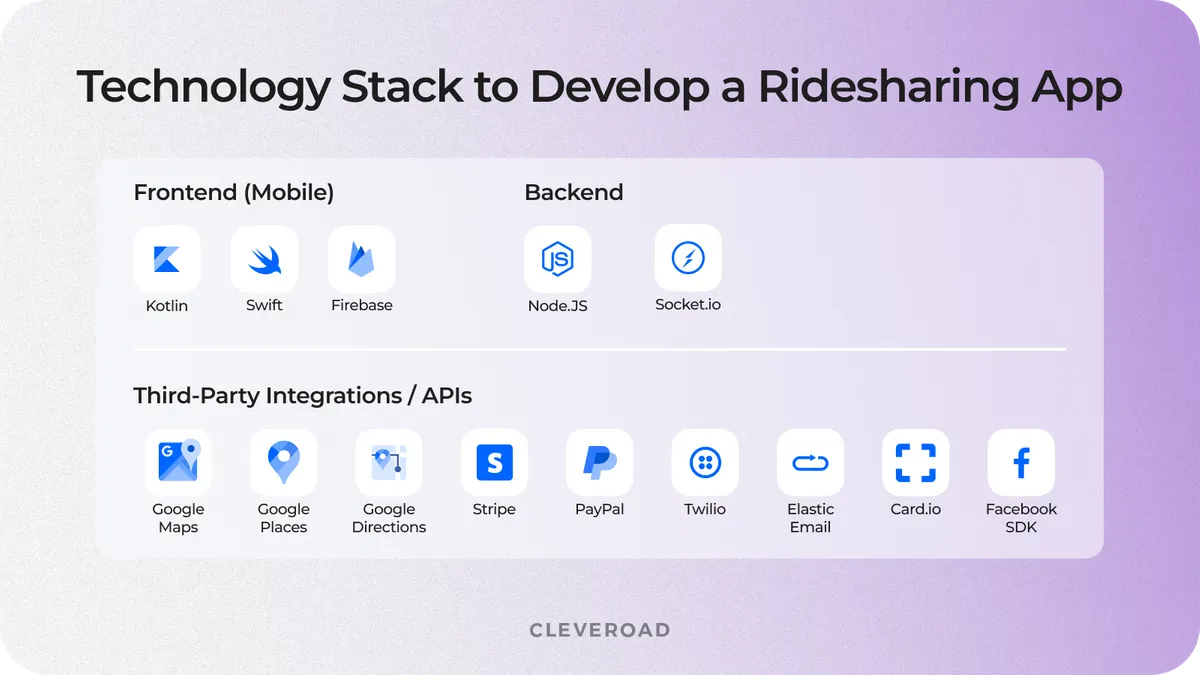
Technology stack to develop a ridesharing app
Quality assurance
Before launch, your team must thoroughly test the application to ensure it works as intended across devices and scenarios. Quality assurance services run a combination of manual and automated tests to identify bugs, check core functionality, verify performance under load, and confirm UI consistency. If issues appear, the app is returned for fixes and retested. Only after passing all checks is the product considered ready for release. This step is essential to guarantee that your ride-sharing app development results in a stable and user-ready product.
App launching
Once the QA team approves the final build, developers prepare the app for deployment to the App Store and Google Play. This process includes finalizing build versions, preparing store assets (screenshots, descriptions, icons), and ensuring that the application complies with each platform’s submission requirements. These include privacy policies, UI and content standards, data usage disclosures, and legal disclaimers. Both Apple and Google conduct a review before making your app publicly available, which can take from several hours to a few days, depending on the app’s complexity.
Ongoing support and maintenance
After launching the app, you need a reliable support and maintenance process from your vendor to keep your solution running smoothly. This includes monitoring performance, resolving user-reported issues, and adapting the app to new operating system versions or devices. Regular updates may also introduce new features or improvements based on user feedback and analytics. Continuous maintenance is critical if you want to build a ride sharing app that stays relevant, secure, and competitive in a fast-changing ridesharing industry.
How Much It Costs to Create Your Own Rideshare App
The time and cost to create an app for ridesharing always depend on the functionality you want to include. For example, developers need 9 hours to create a simple login option combining email, phone, and password. But if you want to add sign-ins via Facebook, it's another 8 development hours.
We’ve broken down the estimated development time for each core feature of a rideshare app. The table below shows how long it takes to build each element separately, so you can understand where most of the time goes.
| Ride-sharing app module | Approx dev time for one platform (h) | Approx dev time for two platforms (h) | Approx dev time for web (h) |
Passenger module | 331.5 hours | 663 hours | 216.5 hours |
Driver module | 225 hours | 450 hours | 166.5 hours |
Admin panel | 339 hours | ||
Total | 556.5 hours | 1 113 hours | 722 hours |
If we sum up the development hours for all features across the passenger module, driver module, and admin panel, the total cost of development (excluding design, planning, and testing) comes to $86,000+ for one platform, $95,000+ for two platforms, and $36,100+ for the web development of the modules listed above. These estimates are based on an average development rate of $50/hour, which is typical for Central and Northern Europe.
However, the total development budget is not just the sum of feature creation. It also includes other crucial processes like UX/UI design, architecture planning, quality assurance, and project management, which are estimated separately. The next table shows how these elements add to the overall development for the two platforms' cost:
| Rideshare app creation process | Approx time (h) | Approx cost ($) |
Development | 1,835 hours | $91,750 |
Design | 195 hours | $9,750 |
PM time | 300 hours | $15,000 |
QA time | 600 hours | $30,000 |
DevOps time | 120 hours | $6,000 |
Total | 3050 hours | $152,500 |
Note: The ride-sharing app development cost should be estimated individually, taking into account your project case and idea. The final amount of expenses depends on the functionality complexity, hiring option, developers' hourly rates, and the OS (operating system) you would like to design a solution for. Thus, please remember that the calculations provided in this article are approximate. To get accurate estimate tailored to your unique case, contact us.
Cleveroad Experience in Ride Sharing App Development
Cleveroad is a ride-sharing software development company with headquarters in Estonia, delivering tech services to businesses of all scales. We provide robust last-mile delivery development services, including custom software development, modernization, digitalization, and third-party integrations.
For over 13 years, we’ve been partnering with startups, SMBs, and enterprises to turn their ambitious ideas into market-ready digital solutions. Our team guides each client from concept to launch, ensuring the final product that meets business objectives and delivers measurable value.
To prove our competence in the rideshare app development, let us introduce one of our successful projects. It’s MoveUp, a P2P ridesharing solution for people with special needs.
Our client, a US-based company, focuses on creating inclusive transportation services that empower individuals with disabilities and special medical requirements. They needed a digital platform that would not only offer the core features of mainstream ride-sharing apps but also address accessibility challenges, bulky-item transport, and other specific user requirements. The goal was to create a service that fosters independence and convenience for a wide range of riders, from those with mobility impairments to regular customers.
We built a transportation platform with real-time driver tracking, live maps, instant ride updates, and a unique filtering system tailored to MoveUp’s audience. Instead of standard match-making, the system recommends drivers based on detailed in-app preferences, ensuring users are only matched with vehicles that meet their exact needs — whether that’s a wheelchair ramp, extra luggage space, or specialized seating. Our team also integrated secure payment processing, streamlined booking flows, and ensured the entire app was compliant with accessibility best practices.
As a result, the client received a scalable and user-friendly P2P ridesharing solution ready for market launch. The platform now connects drivers and riders seamlessly, helping people with disabilities, medical conditions, or special transportation requirements travel more easily, while also accommodating regular passengers.
Here is what John Salmon, Founder at Unified Potential, Inc.dba MoveUP, says about his company's collaboration with Cleveroad:
John Salmon, Founder at Unified Potential, Inc.dba MoveUP. Feedback about cooperation with Cleveroad
The following steps indicate the successful building an Uber-like ride-sharing app:
- Gather requirements
- Assemble a development team
- Strategy creation
- UI/UX designing
- Software development
- Quality assurance testing
- App launching
- Ongoing support and maintenance
The must-have features of a rideshare app are:
- Registration & profile
- Push notifications and chats
- Book a ride
- My rides (Passenger)
- Offer a ride (Driver)
- GPS location
- Admin panel
The estimated cost of creating a rideshare app with core functionality, UI/UX design, project management, QA, and DevOps services is around $144,000+ if you work with a development team from Central or Northern Europe at $50/hour. This estimate includes a service fee for development features for passengers, drivers, and an admin panel. Keep in mind that the final cost depends on your specific feature set, design complexity, and hiring model.
The ride sharing app like Uber or maybe like Lyft, can vary depending on what features you want to add, whether it will be a simple taxi app or a full-fledged rideshare app for Android and iOS. Creating a second one requires approximately 2,900+ development hours, covering mobile apps, backend, web admin panel, design, QA, project management, and DevOps. Depending on the team size and collaboration model, this can take 4 to 6 months or longer to deliver a production-ready version.
Focus on solving a real transportation need, ensuring a smooth user experience, fast GPS tracking, and reliable payments. To truly succeed, build a ride-sharing app that’s easy to use, scalable, and regularly updated based on user feedback. Partnering with a skilled tech team also plays a key role in long-term success.

Evgeniy Altynpara is a CTO and member of the Forbes Councils’ community of tech professionals. He is an expert in software development and technological entrepreneurship and has 10+years of experience in digital transformation consulting in Healthcare, FinTech, Supply Chain and Logistics
Give us your impressions about this article
Give us your impressions about this article
Comments
2 commentsHighly detailed analysis and financial projections with costs given. Excellent!
Nice! I will like to engage your company soonest
